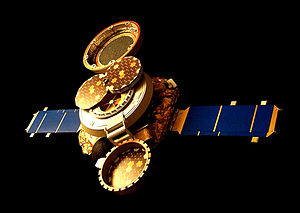
Back مسبار جينيسس الفضائي Arabic Генэзіс (капсула) BE-X-OLD Дженезис (космически апарат) Bulgarian Genesis (nau espacial) Catalan Genesis (sonda) Czech Genesis (Raumsonde) German Sonda Génesis Spanish Genesis (espazio ontzia) Basque Genesis (luotain) Finnish Genesis (sonde spatiale) French
 In its collecting configuration, the Genesis spacecraft exposed several types of solar wind collectors, as well as ion and electron monitors. | |
| Mission type | Sample-return mission |
|---|---|
| Operator | NASA · JPL |
| COSPAR ID | 2001-034A |
| SATCAT no. | 26884 |
| Website | genesismission |
| Mission duration | 3 years, 30 days, 23 hours, 44 minutes[1] |
| Spacecraft properties | |
| Manufacturer | Lockheed Martin Space Systems |
| Launch mass | 636 kg (1,402 lb)[2] |
| Dry mass | 494 kg (1,089 lb)[3] |
| Dimensions | 2.3 × 2.0 m (7.5 × 6.6 ft)[3] |
| Power | 254 W (solar array / NiH2 battery)[3] |
| Start of mission | |
| Launch date | August 8, 2001, 16:13:40 UTC[2] (22 years, 9 months, 29 days ago) |
| Rocket | Delta II 7326-9.5 (D287)[2] |
| Launch site | Cape Canaveral SLC-17A[2] |
| Contractor | Boeing |
| End of mission | |
| Landing date | September 8, 2004, 15:58 UTC[2] (19 years, 8 months, 29 days ago) |
| Landing site | Dugway Proving Ground, Utah 40°11′19″N 113°12′46″W / 40.18861°N 113.21278°W |
 Official insignia for the Genesis mission | |
Genesis was a NASA sample-return probe that collected a sample of solar wind particles and returned them to Earth for analysis. It was the first NASA sample-return mission to return material since the Apollo program, and the first to return material from beyond the orbit of the Moon.[4][5] Genesis was launched on August 8, 2001, and the sample return capsule crash-landed in Utah on September 8, 2004, after a design flaw prevented the deployment of its drogue parachute. The crash contaminated many of the sample collectors. Although most were damaged, some of the collectors were successfully recovered.[6]
The Genesis science team demonstrated that some of the contamination could be removed or avoided, and that the solar wind particles could be analyzed using a variety of approaches, achieving all of the mission's major science objectives.[7][8]
- ^ "Genesis: In Depth". NASA Solar System Exploration. Retrieved September 25, 2023.
- ^ a b c d e "Genesis: In Depth". NASA Solar System Exploration. Retrieved February 2, 2020.
- ^ a b c "Genesis". NASA Space Science Data Coordinated Archive. Retrieved February 2, 2020.
- ^ Siddiqi, Asif A. (2018). Beyond Earth: A Chronicle of Deep Space Exploration, 1958–2016 (PDF). The NASA history series (2nd ed.). Washington, DC: NASA History Program Office. p. 2. ISBN 9781626830424. LCCN 2017059404. SP2018-4041.
- ^ The NASA Stardust mission launched two years before Genesis, but did not return to Earth until two years after Genesis's return.
- ^ "Genesis Solar Wind Samples". Curation Series. NASA/JPL.
- ^ Reisenfeld, Daniel B.; et al. (June 2013). "Solar Wind Conditions and Composition During the Genesis Mission as Measured by in situ Spacecraft". Space Science Reviews. 175 (1–4): 125–164. Bibcode:2013SSRv..175..125R. doi:10.1007/s11214-013-9960-2. S2CID 120682800.
- ^ "Genesis Science Team". NASA/JPL.
© MMXXIII Rich X Search. We shall prevail. All rights reserved. Rich X Search